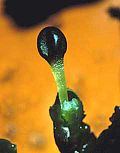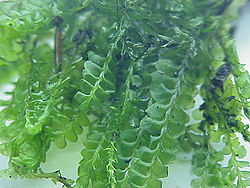Liverwort
The liverworts are a group of simple plants. Scientists believe that liverworts were the first bryophyte to evolve. They believe that mosses, hornworts, and more complex plants then evolved from liverworts. Scientists decided this from mitochondrial DNA.[1]p75
Liverworts are usually placed in the bryophytes, a group of plants without tissue to conduct water. That is why they always need to live near a spring, a river, or in a place where there is a lot of fog or has a lot of rainfall. This group also includes with mosses and hornworts. Recent taxonomy gave them their own division called the Marchantiophyta. However, since the classification is not yet settled, we use the old terms.
Liverworts, as the picture shows, are small plants with flattened bodies, or with flattened stems bearing overlapping scales.[2]p135
The name liverwort comes from the Middle Ages, when plants were selected as medicines according to the false belief that similia similibus curentur (similar heals similar). The liver shape seen in the liverwort Marchantia, for example, was boiled in wine as a medicine against liver problems. The name was then transferred to the whole group.
Reproduction
Liverworts have a gametophyte-dominant life cycle. This means that most parts of them only have one copy of DNA, like mosses. In most plants and animals, most parts have two copies of DNA. Some parts of liverworts have two copies, and they're called the sporophytes. These are stalks that grow sporangia, sacs with spores inside. They're simple, and don't last long.
Liverwort Media
The archegonium of Porella.
Porella platyphylla clump growing on a tree.
Pellia epiphylla, growing on moist soil.
Plagiochila asplenioides, a leafy liverwort.
Riccia fluitans, an aquatic thallose liverwort.
Conocephalum conicum, a large thallose liverwort.
References
- ↑ Willis K.J. and McElwain J.C. 2002. The evolution of plants. Oxford.
- ↑ Schofield W.B. 1985. Introduction to Bryology Macmillan, New York. ISBN 0-02-949660-8.








